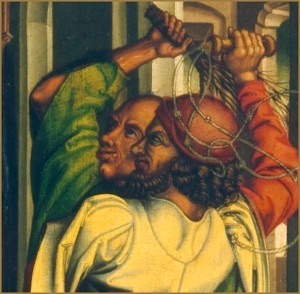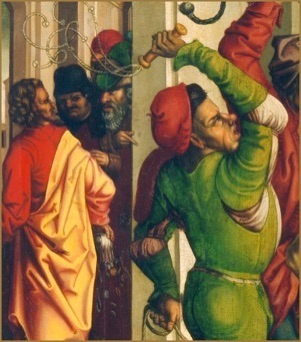The Digitalisation Project Castle Huis Bergh is the intellectual property of the Stichting Musick’s Monument. Ing Hans Meijer was responsible for the technical realisation; Dr Willem Kuiper for the scholarly input. Thanks are also due to the Anjer Cultuurfonds Gelderland; the Stichting de Verenigde Stichtingen “De Armenkorf” in Terborg and “Het Gasthuis te Silvolde”; Mrs P. Tijdink-Hermsen; Mrs L.J.C. Meijer-Kroonder; and the Giese family.







anel
German master. Germany
Scourging of Christ 1480-1500 Partly copy of engraving B-12 by Martin Schonganer (ca. 1445-1491, Colmar) From the Ramboux* collection, Cologne. The back perhaps served as the background of a tabernacle with wooden sculptures. Part of it is gold, with inlaid ornamentation.
The theme of Christ’s scourging, a torture to which he was subjected before his crucifixion, appears in art from the fifteenth century onwards. The German artist who made the panel under discussion has taken great pains to show the beholder who were the bad hats and who were the goodies in this scene. The faces of the villains are contorted in cruel expressions, their red and green clothes making them look like jesters, while the virtuous victim looks vulnerable and frightened, the gold leaf halo indicating his holiness. The instruments that the henchmen use for the flogging are rods, and straps with knots or large bullets attached to the ends. In the lower left-hand corner lie Christ’s clothes; they were removed to make the flogging more painful. We see Judas standing at the back, casting away the thirty pieces of silver, his reward for betraying Jesus. He would meet an awful fate: feeling bitter remorse after Jesus’ crucifixion, and finding himself unable to live with the blame, he ultimately hanged himself. Typical of a fifteenth-century painting such as this is the strange, Escher-like, unreal perspective. Take a close look at the pillar to which Christ is bound: the base is placed in the foreground, but the top is attached to a part of the gothic ceiling in the far rear of the room.
We see one of the Wise Men of the East offering his gift to the baby Jesus, doffing his hat to him. Although the Wise Man lived many centuries earlier, and although he was supposed to be a wealthy Eastern prince, the painter has dressed him in rather Western gothic clothes. The wide sleeves and pointed shoes are typical features of gothic fashion. The star that guided the Magi shines brightly above the manger which, in fact, looks more like a normal house than a stable. Apart from the two other Wise Men of the East who are said to have visited the new-born king, two other witnesses to the nativity are missing here: Joseph and the ox. Mary is the only parent visible, dressed in her characteristic blue cloak, and the ass is the only animal in attendance.
The small pillar that adorns the window of the manger is a reference to the pillar that Christ would later be tied to during his flagellation. Mary and her son both have haloes surrounding their heads, but the Virgin’s is plain gold leaf, while Christ’s is marked with a cross as an indication of his supreme divinity.
